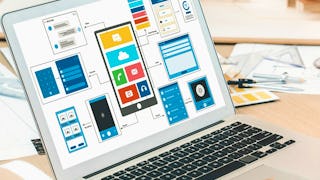Apply the skills you learned during the sequence of courses -- from needfinding to visual design -- as you redesign a new interface, service, or product for your Interaction Design Capstone Project. We’re working with some exciting design teams in Silicon Valley across multiple industries to develop real-world design challenges for this final project. Upon completion, you will have a polished capstone project you can share in your design portfolio to highlight your work and document your design process.


Interaction Design Capstone Project
This course is part of Interaction Design Specialization

Instructor: Scott Klemmer
5,148 already enrolled
Included with
(163 reviews)
Skills you'll gain
Details to know

Add to your LinkedIn profile
See how employees at top companies are mastering in-demand skills

Build your subject-matter expertise
- Learn new concepts from industry experts
- Gain a foundational understanding of a subject or tool
- Develop job-relevant skills with hands-on projects
- Earn a shareable career certificate

There are 10 modules in this course
Welcome to the Interaction Design Capstone Project!
What's included
3 videos1 reading
As Yogi Berra said, you can observe a lot just by watching. Watching how people do things is a great way to learn their goals and values, and come up with design insight. We call this needfinding. This module trains your eyes and ears to come up with user needs, breakdowns, clever hacks, and opportunities for improvement.
What's included
2 videos1 reading1 peer review1 discussion prompt
To maximize your chances of having a great idea, it helps to generate a lot of ideas. Brainstorming is a strategy for rapidly generating lots of ideas. It was named by advertising executive Alex Osborn in his 1953 book, Applied Imagination. When brainstorming, go for volume and defer judgment. Often, something that seems like a crazy idea can lead to something that’s a really good idea. Immerse yourself: it can help to use a whiteboard, butcher paper, or stick post-its on a wall. These ideas will become the 'soil' for growing your designs.
What's included
1 video1 peer review1 discussion prompt
Prototyping is the pivotal activity that structures innovation, collaboration, and creativity in design. Prototyping gets ideas out of your head and into the world. Like a conversation, your ideas will evolve as you articulate them and make them concrete. Prototypes are quick and dirty, not careful museum pieces. The key to prototyping is to jump right in. It’s a tool to see what’s working, what challenges emerge, and to share your ideas with others. Review the user needs you brainstormed. In this assignment, you will flesh out your design ideas by storyboarding and making paper prototypes.
What's included
1 video1 reading1 peer review1 discussion prompt
Design can succeed (or fail) in many ways. That said, there are common heuristics that will get you on the right path. In this module, you will conduct heuristic evaluations (HEs) of another learner's paper prototype. The heuristic evaluations will be a way to highlight usability issues, and think about how to improve them.
What's included
3 videos1 peer review1 discussion prompt
A journey of a thousand miles begins with a single step. Figuring out what that first step is--and then what the one after that is--can be especially daunting with creative projects. Making forward progress is a lot easier if you write down concrete, actionable goals. This is the main benefit of a development plan. A development plan also helps you track momentum. Are things progressing at the pace you expected? Faster? Slower? Writing a time estimate into your plan and tracking how long it actually took helps you gauge your pace. The first steps of your plan should be the skeleton that forms the core screens of your design.
What's included
1 peer review1 discussion prompt
Crunch time! Your interactive prototypes have to be ready for user testing by the end of this assignment.
What's included
1 peer review1 discussion prompt
In this assignment, you will test your prototype in person with two people to find usability bugs & potential improvements.
What's included
1 video1 peer review
You've got data from online users that compares two alternatives. How can you tell whether there is a real difference? Statistical tests, like the CHI-squared test, tell you whether the behavior you observed was likely to have occurred by chance, or whether there's likely to be a real difference between the designs. A/B experiments like these are becoming increasingly popular in industry because experiments help you test your assumptions.
What's included
2 videos1 reading2 peer reviews1 discussion prompt
You've done all this great work, and your hard effort has paid off. You've brainstormed, prototyped, designed, iterated, refined, and evaluated. Now's your chance to share your work with the world. This is a great opportunity to tell your design story, and use it as a portfolio to impress your friends, family, and potential employers.
What's included
1 peer review1 discussion prompt
Earn a career certificate
Add this credential to your LinkedIn profile, resume, or CV. Share it on social media and in your performance review.
Instructor

Offered by
Explore more from Design and Product
 Status: Free Trial
Status: Free Trial Status: Free Trial
Status: Free TrialUniversity of California San Diego
 Status: Free Trial
Status: Free TrialUniversity of Michigan
 Status: Free Trial
Status: Free TrialUniversity of California San Diego
Why people choose Coursera for their career




Learner reviews
163 reviews
- 5 stars
72.39%
- 4 stars
17.79%
- 3 stars
4.29%
- 2 stars
2.45%
- 1 star
3.06%
Showing 3 of 163
Reviewed on May 2, 2017
Amazing course, it push you to go through the right design process making it fun and useful
Reviewed on Aug 17, 2019
Although I do not have any design background, I can still handle the workload and learn from my classmates.
Reviewed on May 30, 2018
I can't reach the course contents because of new deadline that Coursera has invented

Open new doors with Coursera Plus
Unlimited access to 10,000+ world-class courses, hands-on projects, and job-ready certificate programs - all included in your subscription
Advance your career with an online degree
Earn a degree from world-class universities - 100% online
Join over 3,400 global companies that choose Coursera for Business
Upskill your employees to excel in the digital economy
Frequently asked questions
This course is the last course to the Interaction Design Specialization. It is only made available to those who have already completed all the previous seven courses in the specialization.
To access the course materials, assignments and to earn a Certificate, you will need to purchase the Certificate experience when you enroll in a course. You can try a Free Trial instead, or apply for Financial Aid. The course may offer 'Full Course, No Certificate' instead. This option lets you see all course materials, submit required assessments, and get a final grade. This also means that you will not be able to purchase a Certificate experience.
When you enroll in the course, you get access to all of the courses in the Specialization, and you earn a certificate when you complete the work. Your electronic Certificate will be added to your Accomplishments page - from there, you can print your Certificate or add it to your LinkedIn profile.
More questions
Financial aid available,
¹ Some assignments in this course are AI-graded. For these assignments, your data will be used in accordance with Coursera's Privacy Notice.

